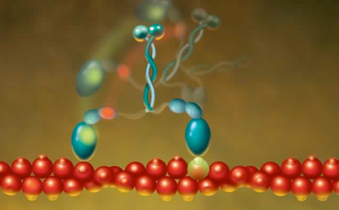You move the mouse on your computer, click on a link and here is something to read about muscles. But how did your finger move the mouse in the first place. Well that is easy, you have muscles that are wired into your brain and pretty much it happens. If you had to build a machine to do that, it might be hard, but imagine if you had to build a machine that was really small like a few nanometers in size? Maybe biology can show you how.
Biology is full of tiny machines, muscles are machines and inside of your muscles are cells and inside of these cells are littler machines. Bacteria also have little machines that help them move. Can nanotechnology use these biological machines? Sure, in lots of different ways.
There are few different machines found inside of cells. One machine involves something called myosin, a protein. Every motor needs energy and myosin uses ATP (adenosine triphosphate) same as other motors found inside of cells and also bacteria. Myosin is a linear motor sort of like an elevator, it moves in one direction guided by another molecule, actin. Every time myosin uses one molecule of ATP fuel it can move 74 nanometers. It would take about one thousand ATP molecules to move about the width of a hair.
Scientists have taken molecules like myosin and actin and studied the way myosin moves. Using powerful microscopes and other tools, they have learned that myosin moves along sort of the way that you climb a ladder, hand over hand. So while practical motors have not been built to use these nanometer scale motors, they are all around you. Move your finger and you get to see billions of them in action.
Image Source: Weisshaar Group | BIDMC

